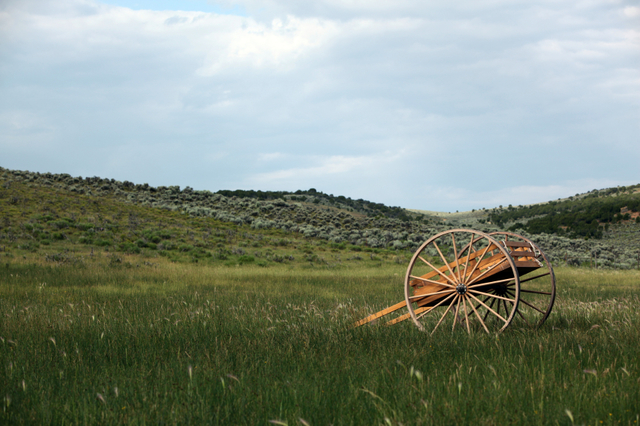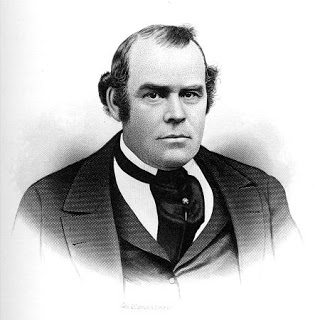
This article was written by Brittany Chapman Nash and Richard E. Turley Jr. and appeared in the 19 April 2016 online edition of LDS Living Magazine. This is an excerpt from their new book titled “Fearless in the Cause” which can be purchased from Deseret Book.
Newly converted to the restored gospel, Laura Clark Phelps and her husband, Morris, gathered with the Saints to Jackson County, Missouri, in March 1832. There, in a borrowed tent, Laura gave birth to their third child, a daughter that family lore claims was the first Mormon girl to be born in Independence. The Phelps family was soon driven with the rest of the Saints from Jackson County into clay County, and finally to Far West, Missouri.
As persecution against the Saints escalated, confrontations with mobbers became increasingly harsh. Laura’s daughter Mary Ann recalled: “they [the mobbers] would even come into her yard and shoot the chickens and kill the pigs. Mother had her house full of women and children, in the meantime, who had been driven from their homes by the enemy. These women wanted mother to go into the woods to escape the mob, but she told them ‘No,” that if she had to die, she would die in her own home, so they decided to stay with her.”
During those dark and threatening times in 1838, Laura’s husband, Morris, was arrested and thrown into the Richmond Jail with Parley P. Pratt and four others while Joseph and Hyrum Smith and five others were taken to Liberty Jail. Laura’s daughter Mary Ann noted: “Father was told many times that if he would burn his Mormon Bible and quit the Mormon church he could go free. . . but he chose to be firm in his religion; so he was held in prison all winter, and mother had to support her family the best way she could; her provisions and everything had been destroyed by the armies.”
Amazingly under such circumstances, Laura managed to visit her husband every two weeks and take him provisions so he had something to eat besides the prison food that was often inedible. On one of those occasions, she discovered that Heber C. Kimball had also come to visit the prisoners. He recalled the event in his journal: “On our arrival at Richmond, I went directly to the prison to see Parley, but was prohibited by the guard, who said they would blow my brains out if I attempted to go near him. In a few minutes, Sister Morris Phelps came to me in great agitation and advised me to leave forthwith, as Brother Pratt had told her that a large body of men were assembled with tar, feathers, and a rail, who swore they would tar and feather me, and ride me on the rail.”
Elder Kimball later expounded: “When my life was sought at Richmond, and my brethren in prison had great anxiety on my account, she interceded with my pursuers, who were nearly thirty in number, and actually convinced them that I was another person, altogether, and the pursuit was stopped.” Laura’s courageous spirit may have saved his life.
After Governor Lilburn W. Boggs issued the infamous extermination order, Laura packed up her children and what few possessions she could and left Missouri. With her husband still in jail, she drove a wagon from Far West, Missouri across the Mississippi River to Quincy and then Commerce, Illinois, and then back across the Mississippi to Montrose, Iowa, where her family settled in an abandoned building that had been used to stable horses.
Despite the distance, Laura was determined to return to Missouri to see her husband and attend his trial. Her brother, John Wesley Clark, joined her for the 150-mile journey on horseback. They arrived in Columbia, Boone County, Missouri, where Morris, Parley P. Pratt, and King Follett had been transferred. Laura found that Orson Pratt, brother of Parley, had also come to attend the court proceedings. They yearned for the freedom of their family members, and the Lord had a plan for their liberation. Parley recorded that before Orson and Laura arrived, “The Lord had showed me in a vision of the night the manner and means of escape [from jail]. Mrs. Phelps had the same things shown to her in a vision previous to her arrival.”
The daring escape attempt required great courage and resolve. The plan was for Laura to arrange boarding for a few weeks with the family of the jail keeper, who occupied part of the building that held the prison. This served the double purpose of lowering the jail keeper’s guard and making Laura’s horse available (along with her brother John’s horse and Orson Pratt’s horse) for the three prisoners to make their escape.
The breakout was carefully planned. The prisoners were to await the opening of their upstairs cell door by the jailer. Parley P. Pratt recounted the strategy:
“Mr. Follett was to give the door a sudden pull, and fling it wide open the moment the key was turned. Mr. Phelps being will skilled in wrestling was to press out foremost, and come in contact with the jailer; I was to follow in the centre, and Mr. Follett, who held the door, was to bring up the rear, while sister Phelps was to pray.”
Laura’s daughter related the adventure:
“Mother said she sat in back on the bed in the kitchen, and pretty soon she could hear steps and a rumbling noise, heard the jailer call out, and she said his wife rushed up stairs to where he was (she weighed about two hundred pounds). The jailer had father clinched, but father jumped down two pair of stairs, six steps each, and with the jailer’s wife hanging on to one of his arms. He would get rid of her when he jumped, but she would clinch him again when she reached him. . . Mother said. . . she thought she could pray if she could do nothing else. She thought she was whispering a prayer, but they said she hollered just as loud as her voice would let her, and she said, ‘Oh! Thou God of Abraham, Isaac and Jacob, deliver Thy Servant.’ Father said he felt as strong as a giant when he heard those words; he just pushed the jailer and his wife off as if they were babies and cleared himself.”
Meanwhile, Orson and Laura’s brother John held the horses at the agreed-upon meeting point. Morris and Parley were able to get away, but King Follett was captured on Laura’s horse, which was strong evidence of her participation in the plot. As news of the escape spread, Laura faced alone the wrath of a mob who gathered around the prison.
It is remarkable that Laura chose to remain at the scene, her own life at risk. According to Parley: “They threatened her with instant death, and finally turned her out of doors in the dusk of the evening. . . Being a stranger and without money, friends, or acquaintances in the place, she knew not where to go or what to do. She finally sat down in the open air in the midst of the mob, by whom she was assailed, cursed, insulted, threatened, and abused in the most unfeeling manner for some time.”
A little boy who witnessed the scene heard the jailer threaten to “put [Laura] out of the way” if she were not gone by dark. The boy ran home and returned with his parents, who were appalled at the cruelty directed at Laura. The Richardson family took pity on her and gave her refuge in their home.
They proved to be true friends. The next day they returned to the jail and collected items belonging to Morris. They searched until they found Laura’s sidesaddle, which the mobsters had vandalized. After a few days, Mr. Richardson located her horse, which had been abused by the mob in their pursuit of Morris and Parley after the recapture of King Follett. Mr. Richardson repaired the saddle and nursed the horse back to health. Laura’s daughter Mary Ann recorded, “Mother stayed with these good people ten days; never heard a word as to whether father was dead or alive, but mother was a woman with lots of faith and courage.”
Laura was determined to return to her family in Iowa, despite the Richardsons’ concerns about the dangers for a woman traveling alone through unsettled country where bandits roamed. Finally, they all agreed that Laura would travel a good part of the way with the mail boy, settling out early in the morning and ride late into the night. Leaving the Richardsons with a Book of Mormon and a hymnbook, Laura began the journey.
Traveling alone for the last leg of her journey, Laura entered an area of thick woods just as darkness began to fall. Her daughter wrote, “She said this was the first time her courage failed her, she had such a lonesome, dismal feeling come over her. . . and she did not know what would accost her.” Then, amazingly, she saw a man approaching on horseback. It proved to be King Follett’s son who had been sent to find out if Laura had ended up in prison because no one had heard from her. Together they traveled to Quincy, Illinois, where Morris was recovering from his eight months in prison and three days without food or rest during his escape. Laura also found that Orson Pratt and her brother John had safely arrived there after walking more than a hundred miles from Columbia, Missouri. King Follett was eventually released from jail several months after his recapture on account of his age and his not being a Church leader.
Laura and Morris still feared for Morris’s safety and did not dare to stay long with the kind of people in Quincy. After only a few days, they left their children with neighbors and traveled to Kirtland, Ohio, to visit Morris’s family. They attempted to teach his Phelps relatives the gospel but to no avail.
After a lengthy time away from Illinois, the family was reunited in July 1840, but their season of happiness was short-lived. Laura’s daughter Mary Ann recalled: “We moved to a town twenty miles from Nauvoo called Masedonia, here we located and soon all were our friends. . . We lived there about a year and a half, which were the happiest days of our lives; then my mother was taken sick and died, leaving her five children, three girls and two boys, the baby one and a half years old. We were all heartbroken and did not know how to manage without mother. She was buried in Nauvoo. . . Hard work and exposure had broken her health.”
Among the many tributes given at Laura’s funeral, Heber C. Kimball said, “She was one of the first who embraced the gospel. . . [and] manifested to the world that no sacrifice was too great for her to make for the cause which she had espoused.” The Prophet Joseph Smith said “her salvation was sure.” An entry about her in the compiled History of the Church concluded simply, “Her rest is glorious.”
About Guest Author
Twitter •


 Watch a video about the restoration of the gospel on lds.org
Watch a video about the restoration of the gospel on lds.org